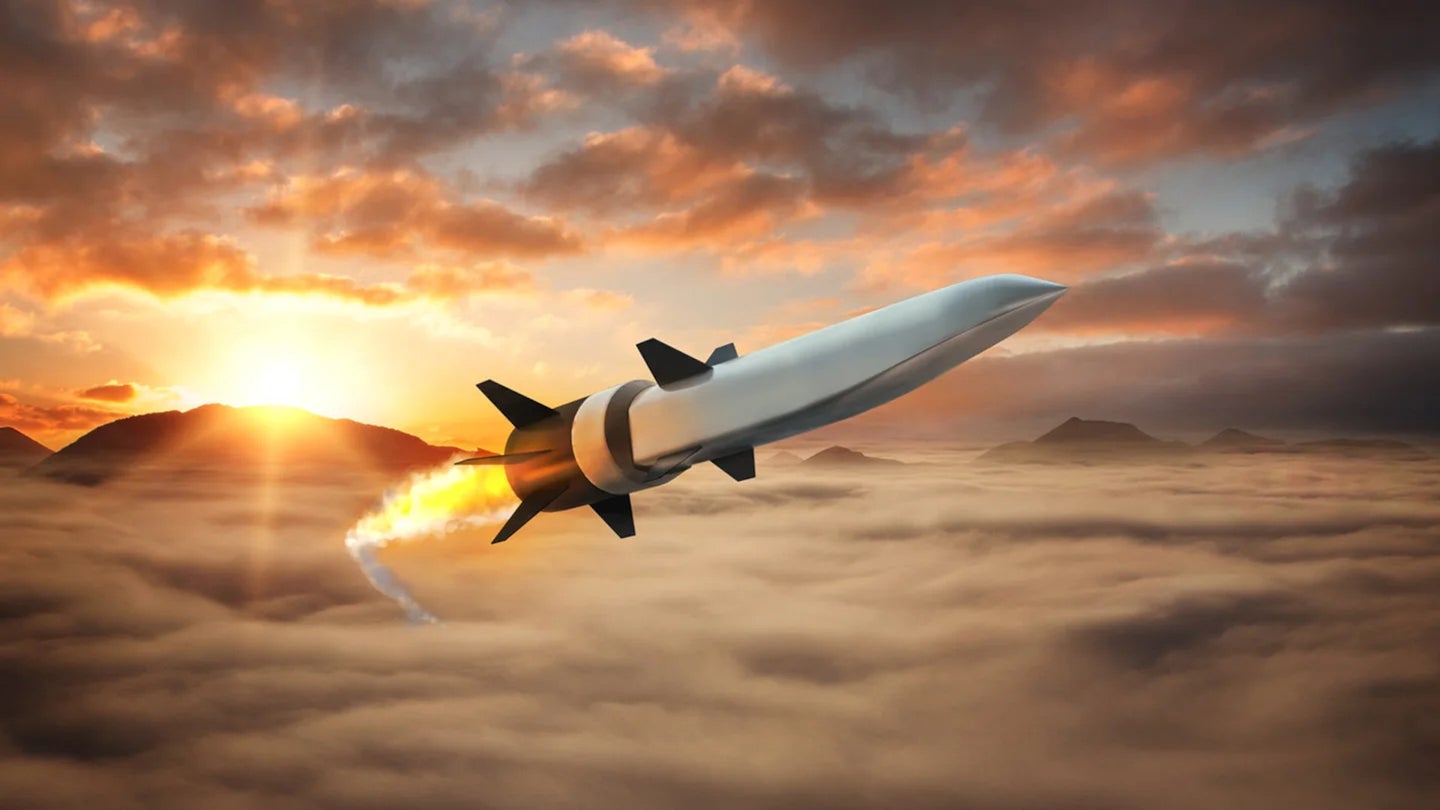U.S. Secretly Performs Test of Scramjet-Powered Hypersonic Missile
The United States successfully tested a scramjet-powered hypersonic missile in secret last month, according to new Lockheed Martin and DARPA press releases. Hypersonic missiles are advanced new weapons capable of exceeding Mach 5, or about 3,838 miles per hour, in flight. The combination of speed and maneuverability provided by these weapons makes them practically impossible to intercept using existing missile defense technologies.
While Russia and China already have hypersonic boost-glide weapons in service, the United States appears to be the front runner in fielding scramjet-powered hypersonic missiles.
This successful test was of the Lockheed Martin variant of the Hypersonic Attack Cruise Missile (HACM), a high-speed weapon that leverages advanced new scramjet propulsion to attain hypersonic velocities. Development of this weapon has been a joint effort by the Defense Advanced Research Projects Agency (DARPA), Air Force Research Lab (AFRL), Lockheed Martin, and Aerojet Rocketdyne.
“Hypersonic systems provide a combination of speed, maneuverability and operating altitude that enables highly survivable, long-range capability for the rapid defeat of time-critical, heavily-defended, and high-value targets,” Eric Scherff, Vice President of hypersonic strike programs at Lockheed Martin Space, told Sandboxx News in January.
This is the second success for the DARPA-led HAWC missile effort, but the first using a Lockheed Martin scramjet propulsion system. The previous successful test was of a Raytheon-built HAWC missile powered by a Northrop Grumman-sourced scramjet. Although scramjet technology has been the subject of study for decades, no nation has ever successfully fielded a scramjet-powered operational system (weapon or vehicle) of any sort.
“This Lockheed Martin HAWC flight test successfully demonstrated a second design that will allow our warfighters to competitively select the right capabilities to dominate the battlefield,” said Andrew “Tippy” Knoedler, HAWC program manager in DARPA’s Tactical Technology Office.
“These achievements increase the level of technical maturity for transitioning HAWC to a service program of record.”
Like traditional cruise missiles, the HACM flies along a fairly stable trajectory (like an aircraft), with the ability to maneuver mid-flight to avoid being intercepted. According to reports, the missile was carried into the sky aboard a B-52 Stratofortress somewhere off the West Coast, powered first by a conventional rocket booster and then by the Lockheed Martin scramjet once it was traveling at sufficient speed for the scramjet.
There are no currently available figures on the HACM’s top speed or range, but reports indicate this recent test was conducted at “moderate” hypersonic speeds just above Mach 5 at an altitude higher than 65,000 feet for more than 300 miles. At these speeds, covering 300 miles would take less than five minutes of flight time.
Related: Is America really losing the hypersonic arms race?
Russia and China lead the world in hypersonic boost-glide weapons

Hypersonic missiles have been the subject of what some have called a modern-day arms race, with Russia, China, and the United States all rushing to develop and field different types of high-speed weapons. Modern hypersonic weapons come in two forms: hypersonic boost-glide vehicles and scramjet-powered cruise missiles. To date, Russia and China both have hypersonic boost-glide vehicles in service, but no nation has managed to master scramjet technology to field a hypersonic cruise missile just yet.
“Going Mach 5, sometimes even faster, generates extreme levels of heat, driving the need for innovative materials, sensors and electronics to withstand such speeds throughout its journey,” Dave Berganini, Vice President of hypersonic and strike systems at Lockheed Martin Missiles and Fire Control, told us via e-mail in January.
“In addition to heat, these systems must be able to maintain consistent communication connections, as well as considerable intelligence to perform precise maneuverability techniques to overcome a wide range of advanced defense systems and extreme contested environments.”

Hypersonic boost-glide vehicles aren’t all that different from the warheads on traditional long-range ballistic missiles, at least in the early stages of their flight path. They are carried into the upper atmosphere via high-velocity boosters just like traditional ICBMs (though usually to a lower altitude). The missile then deploys one or more glide vehicles that rely on momentum and control surfaces or maneuvering thrusters to manage their high-speed descent as they close with their targets.
To date, the only hypersonic weapons in service for any nation belong to this category, including Russia’s Avangard nuclear boost-glide weapon and China’s DF-ZF anti-ship weapon. Both of these weapons are considered nuclear-capable, while the United States has committed to only developing conventionally-armed hypersonic weapons.
Related: The groundbreaking hypersonic missiles America has in the works
America appears to be the frontrunner in fielding scramjet-powered hypersonic cruise missiles

Hypersonic cruise missiles like HAWC are completely different than boost-glide weapons. They rely on an advanced propulsion system called a scramjet for powered flight, rather than gliding at high speeds from high altitudes. A scramjet, or supersonic combusting ramjet, is a variation of tried and true ramjet technology that allows combustion to take place with supersonic airflow. Because scramjets are really only efficient at high speeds, these missiles are often deployed from fast-moving aircraft or rely on a different form of propulsion to get them to these speeds—like the rocket booster used for the recent HAWC missile test.
America has over 70 hypersonic weapons programs in various stages of development, with a number of parallel efforts in both boost-glide vehicles and scramjet-powered cruise missiles. However, America’s efforts have been slow-going and rife with failure. Of 17 total hypersonic weapons tests over the past 12 or so years, ten have been either partial or complete failures. However, many failures associated with scramjet efforts haven’t been from the scramjet themselves, but rather technical difficulties with unrelated support systems like rocket boosters.
The success of a second HAWC missile design now suggests that the United States, despite its reputation as being behind in hypersonics, may actually be the front-runner when it comes to scramjet systems.
“While recent flight tests haven’t gone as planned, we accomplished many first-time events and we continue to gain technical maturity through testing,” LM’S Berganini explained in January. “The high-complexity and unique features of these systems, requires rigorous testing, learning from discoveries, and then maturing the technology to get it right the first time they may need to use it.”
Scramjet technology has been such a challenging nut to crack in large part because of how tough it is to keep combustion lit with air flowing through the engine at Mach speeds. The nature of this challenge has been described as “trying to keep a candle lit in a hurricane.”

Russia claims to have been testing its own scramjet-powered cruise missile in the 3M22 Zircon (also spelled Tsirkon) in 2021, though, to date, little evidence of the missile’s success has surfaced. Severe financial sanctions and penalties levied on Russia following its invasion of Ukraine earlier this year are sure to set Russia’s hypersonic efforts even further back.
Russia’s KH47M2 Kinzhal, the nation’s first claimed hypersonic missile, saw its first operational use in Ukraine last month. Although the weapon’s use saw a great deal of fanfare, the missile itself isn’t groundbreaking technology at all. The Kinzhal is an air-launched ballistic missile based on Russia’s existing 9K720 Iskander short-range ballistic missile, and it achieves hypersonic velocities in the same way traditional ballistic missiles do. Though Russia does claim this missile has some degree of maneuverability through every phase of its flight path, which (if true) would set it apart from previous ballistic missiles.
Read more from Sandboxx News
" Conservative News Daily does not always share or support the views and opinions expressed here; they are just those of the writer."





